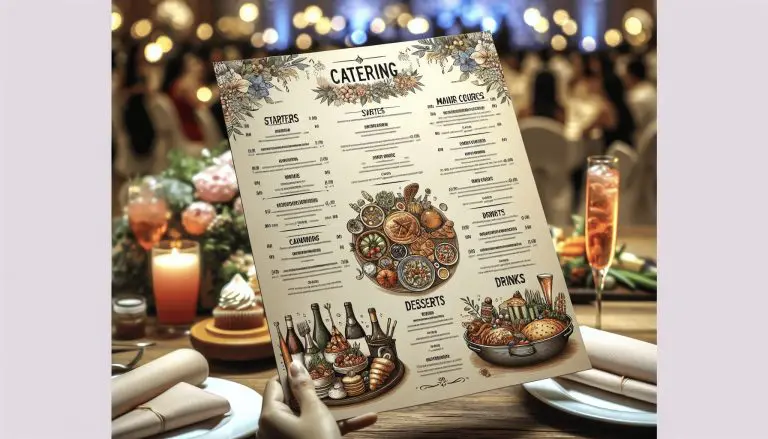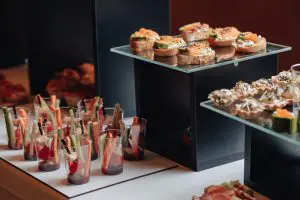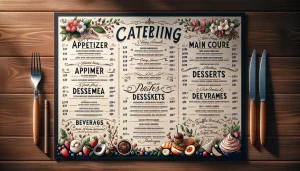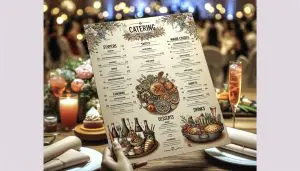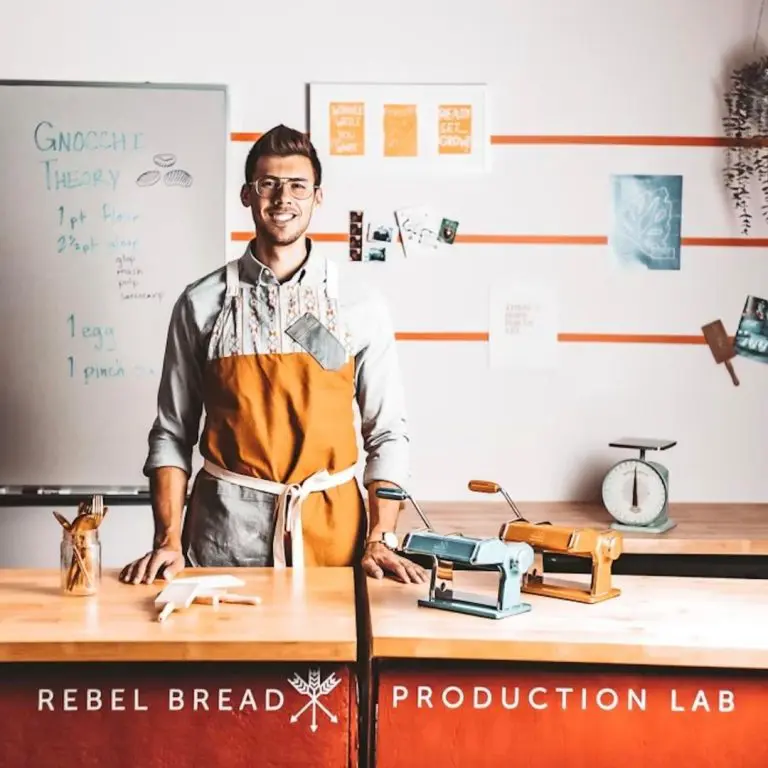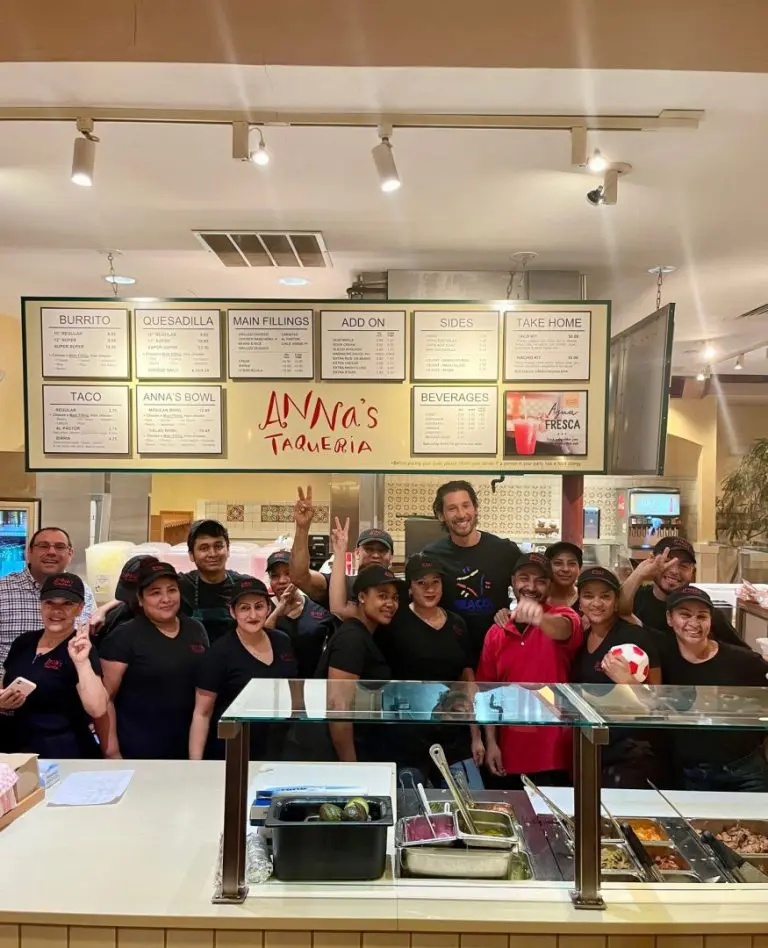Picture this: a high-profile event, from the glamorous guest list to the alluring ambiance, but the one thing that steals the show isn’t the live band or the stunning decor – it’s the food. Executing such culinary excellence isn’t a stroke of luck, it’s an art, mastered through the thoughtful creation of an exceptional catering menu. If you’ve ever wondered what really goes into the planning and presentation of these gastronomic wonders, you’re about to step behind the scenes. Develop a catering menu that becomes the highlight of any event; this article will guide you through the essentials of assembling a remarkable selection of dishes and presenting them in an inviting manner.
📈 Booming Catering Market 🚀
In 2023, the U.S. catering business grossed over $60 billion, equating to $7000 for every New York City resident, showcasing the industry's vast scale and influence.
It all hinges on one critical component: the menu. Not just a list of dishes, a menu is the backbone of every catered event, a road map to a memorable culinary journey. With this ultimate guide, you’ll navigate the ins-and-outs of crafting a successful catering menu and gain insights into trends defining the catering space in 2024.

Metrobi is transforming catering deliveries
Specialized solutions for catering businesses:
- Catering-trained drivers
- Proper handling equipment
- Peak day delivery support
- 23% average cost reduction
Understanding the Catering Menu: A Comprehensive Guide
What Constitutes a Catering Menu?
Every great catering menu, much like a captivating symphony, starts with a variety of perfectly orchestrated components. Similar to how the right blend of various musical notes can make or break a performance, the right balance of appetizers, main courses, desserts, and beverages can truly set your catering menu apart. Explore this post for a selection of 12 enticing examples of catering menus and complimentary design tips that will empower you to create visually appealing and tastefully balanced menus sure to impress your clients.
For starters, appetizers offer the first impression of your culinary prowess and set the tone for the menu. They should be enticing, visually appealing and a prelude to the subsequent courses.
The main course, undoubtedly, is the star of the show. It showcases your ability to handle complex recipes and provide a well-rounded, tasty experience. Bear in mind that a good main course section includes various proteins, vegetables, and well-matched sides.
Desserts often echo the last note in your culinary symphony, leaving a lasting impression on your guests. They should be a blend of well-loved classics and trend-driven treats.
Finally, your beverages need to harmonize with the flavours across the courses. They should offer a mix of alcoholic and non-alcoholic options and match the palate of your target market. Remember, variety and balance in a menu don’t just add flavour, they bring the whole culinary experience to life. Metrobi assists in enriching this culinary journey by offering delivery services across more than 20 cities in the US, including the option for same-day deliveries in cities like Denver.
How to Create a Catering Menu: Step-by-Step
Creating a successful catering menu is both an art and a science. It involves understanding your audience’s desires and crafting a menu that speaks to them. At Metrobi, we excel in managing the distribution for catering businesses, ensuring your delightful creations reach their destination efficiently.
Step 1: Identify Your Target Audience
Knowing your audience is like owning a GPS in the culinary world – it navigates you towards the right direction. Understand their tastes, preferences and even allergies to inform what to include in your menu. At Metrobi, we support this journey by offering delivery services across more than 20 US cities, featuring same-day delivery options in Philadelphia.
Step 2: Choose Your Menu Items
With a clear understanding of your target market, you can then commence the exciting process of choosing your menu items. You’ll want to consider a mix of classic favourites, trendy delights, and a few surprises to keep your menu exciting.
Step 3: Consider Dietary Restrictions and Preferences
Increasingly, catering menus are expected to cater to a wide range of dietary preferences and restrictions such as vegan, gluten-free, dairy-free and so forth. Ignoring such nuances could potentially limit the appeal of your menu to a wider audience. Metrobi specializes in providing delivery services for caterers, ensuring that diverse menu options reach your clientele efficiently and effectively.
🍃 Dietary Accommodations on the Rise 🌿
Catering to over 95% of dietary preferences, caterers are increasingly adapting to vegan, vegetarian, gluten-free, and dairy-free diets.
Step 4: Determine Portion Sizes
Correct portioning is crucial not just from a cost perspective but also in ensuring your guests are well-fed and contented. This aspect requires a balancing act between providing value and not overcommitting resources.Step 5: Test and Refine Your Menu
Your menu is not set in stone. It’s a fluid document that needs constant refining based on customer feedback, market trends and even seasonal availability of produce. Remember, always strive for progress, not perfection. With these steps under your belt, the journey to creating a remarkable catering menu is well on its way. Remember, it takes a beautiful symphony of components harmoniously interacting to create a memorable catering experience. Your menu is the sheet music that guides this symphony, defining each note to create a unique melody your audience would love to hear time and again.
Lower your delivery costs by 23%
How we reduce costs:
- No delivery vehicle expenses
- Optimized local routes
- Pay-per-delivery model
- Average 23% delivery cost reduction
Catering Menu Design: Making Your Menu Visually Appealing
Attention to the visual aspect of your menu can drive customer behavior. Effective menu design is more than just aesthetics, it’s a sales strategy.Importance of Good Menu Design
Crafting a visually appealing catering menu isn’t all about high-end graphics and expensive design layouts. It is fundamentally an exercise in psychology, where the visual signals provided by the menu can stimulate desire, increase perceived value, and ultimately influence customers to order more. Beyond creating a positive initial impression, a well-thought-out menu can optimize the customer ordering process, thereby increasing your sales. To this end, a menu isn’t just a list of dishes your establishment can prepare, but a core business tool that communicates your brand, showcases your offerings, and guides customer decisions. Ensuring your catering menu is well-designed should therefore be a top priority.Tips for Effective Catering Menu Design
When it comes to creating an effective catering menu, there are several key elements to consider.Picture Perfect
First, consider using high-quality images. Images can be a powerful tool to showcase your culinary creations. By offering a visual sampling, it can pique the interest of customers and influence their ordering decisions.Typography Matters
Second, pay attention to typography. The text style and font size should be easy to read and consistent throughout the menu. The right typography sets the tone, enhances the overall aesthetic, and aids in information readability, guiding customers through the different sections of your menu.Layout Logic
Next, ensure a logical layout. Arrange items in a way that leads customers on a journey through your offerings. Most importantly, use clever design tactics to highlight your most profitable or signature dishes. You could highlight these items with a box, different colors, or place them where the eye falls naturally, like the top right or center of the menu. An intuitive, logical layout not just simplifies ordering for customers but can also be a subtle guide to higher profitability. Crafting an attention-grabbing, compelling menu design isn’t about being an award-winning graphic designer. It’s about understanding how design elements interface with human behavior – and putting that understanding to work in a way that aligns with your branding and business goals.Catering Menu Ideas: Inspiring Your Culinary Creativity
Expand your menu with popular catering choices for different types of events. Breathe new life into catering with unique and innovative menu ideas.Popular Catering Menu Ideas
If you’re in need of inspiration for your next event, consider these popular catering menu ideas that continue to win over attendees at various occasions. Weddings often call for elegant, classic dishes, such as steak, salmon, or chicken options paired with quality vegetables and grains.
📅 Event Booking Trends
With 80% of weddings booked 5-12 months in advance and corporate events trending towards 3-5 months' planning, the catering industry sees significant lead times.
For corporate events, the menu often leans more towards easy-to-handle foods that can be eaten while networking. Think along the lines of bite-sized appetizers, sandwiches, and wrap platters.
When it comes to parties, it’s all about pleasing broad tastes and creating an enjoyable atmosphere. Pizza, burger sliders, or a taco bar are some crowd-pleasing ideas. Of course, these can be tailored to the theme and nature of the party as well.
Tailoring to the Event
It’s essential not only to think about popular dishes but also to tailor your menu to the event’s specific context. For instance, a summer outdoor event may call for light salads, chilled soups, or barbeque, whereas a winter indoor event might feature hearty soups, roasts, or warming casseroles.
Innovative Catering Menu Ideas
If you’re looking to differentiate your food service, consider innovative catering menu ideas. Start by reconceptualizing classic dishes – for example, instead of a traditional caprese salad, why not serve it skewered as an appetizer? Or rather than separate courses, consider creating an exciting fusion dish that combines the elements of multiple classics.
Tapping into Food Trends
Pay attention to current food trends for inspiration. Whether it’s a culinary trend like food bowls or a societal trend like veganism or gluten-free, incorporating these into your menu can make your service more appealing to a broader audience. Beyond just following trends, try to introduce your unique twist that will make the dishes distinctively yours. Remember, the objective is not merely to imitate but to create something uniquely compelling.
Interactive and Themed Menus
Interactive stations, like a sushi-rolling station or a make-your-own pizza station, are another way to enhance the usual dining experience. Such stations enable attendees to customize their meals and often serve as a fun and engaging addition to the event. Similarly, you could also consider creating themed menus that tie in with the theme of the event itself. Coordinating themes in this way could contribute to a sense of cohesion and immersion at the event.
By exploring a mix of popular and innovative menu ideas, you can ensure a varied, exciting range of options that cater to ever-changing tastes and preferences. This blend ultimately helps to make your catering services stand out in a competitive market.
📈 Booming Catering Market 🚀
Projected to grow to $124.36 billion by 2032,
the U.S. catering market showed a robust size of $72.67 billion in 2023,
expanding at a steady CAGR of 6.2% from 2024.Expanding Catering Services: From Menu to Execution
In the dynamic catering sector, diversifying your catering menu items and offerings is key to meeting the broad spectrum of client expectations. From sit-down catering for elegant gatherings to concession catering at public events, each service type demands a unique approach in menu design and staff coordination. Developing catering packages that cater to various events, including corporate catering services for business meetings and birthday parties, allows for a tailored client experience. This strategy not only showcases the versatility of your catering team but also highlights examples of catering services that can adapt to any occasion. By investing in a skilled catering staff, you ensure the seamless execution of events, reinforcing your brand’s reputation for quality and reliability. Embracing the full range of catering services, from the planning stages through to the delivery by your catering team, positions your business as a comprehensive provider capable of turning any event into a memorable occasion.
💲 Proactive Wage Increases to Counter Staffing Woes 💸
In a move to tackle staffing challenges, 92% of caterers increased wages in 2023, with significant hikes reported by 55%.
Catering Menu Planning: Ensuring a Smooth Operation
The importance of considering factors such as event type, guest count, budget, and venue facilities
How to tailor a catering menu in 6 steps, starting from understanding client needs to finalizing the menu
Before it can inspire your creativity, a catering menu begins with considerate and strategic planning.
Factors to Consider in Catering Menu Planning
A strong catering menu is not solely about an array of sumptuous dishes; it first begins with understanding and considering vital factors that greatly affect its creation. This essential guide dives into the must-have items on your catering menu, ensuring a versatile and appealing selection for all clients.
Event Type
Every event is unique– from a birthday celebration to a corporate event, the type of event heavily influences the menu planning. For instance, a corporate event may require more formal dishes while a family reunion might prefer casual and nostalgic meals. The tone of the event sets the theme of your menu.
Guest Count
A chef can create the most fantastic dish, but if it cannot be scaled to the number of attendees, it may create operational challenges. Knowing if you are catering for a small private gathering or a large conference drastically impacts the menu planning. Understanding common catering menu errors can help avoid planning pitfalls, making sure your menu matches the scale of your event seamlessly.
Budget
Budget constraints might impose restrictions, but they also encourage creativity. Being transparent about budget boundaries helps achieve a balance between cost and quality, paving the way for a menu that pleases both client and caterer.
Venue Facilities
Understanding the venue facilities is key to determining which dishes can be prepared and served successfully. For example, if the venue lacks an ample kitchen area, it would be better to prepare dishes beforehand.
As you embark on catering menu planning, it’s crucial to consider the scope of your service offerings, from social gatherings to future special events, ensuring your business plan encompasses the common types of services requested. Consulting with a business advisor can highlight the importance of additional services and staff to adapt to the dynamic demands of successful events. This holistic approach not only solidifies your operational strategy but also prepares you for the diverse needs of your clientele, setting a foundation for a resilient and versatile catering business.
👥 Staffing Optimism Amidst Challenges 🛠️
Despite 86% of catering companies facing understaffing, there's a positive shift with staffing challenges decreasing significantly from the previous year.
How to Plan a Catering Menu in 6 Steps
A successful catering menu stems from a well-thought-out plan. Here, we break down the planning process into six manageable steps.Understanding Client Needs
Getting to know your client is the first step as their preferences, dietary restrictions and themes will drive the menu. Try to grasp their vision for the event to create a personalized menu.Brainstorming Menu Ideas
Once armed with a clear understanding of the client’s needs, brainstorm menu ideas that align with their preferences and event theme.Evaluating the Practicality of Dishes
Evaluate the feasibility of each dish considering preparation time, equipment needed, ingredient availability, and cost-efficiency. Aim for a balance between vision and operational reality.Tasting and Adjusting
Before finalizing, it’s necessary to hold a tasting session. This allows for adjustments to be made in terms of seasoning, temperature, and presentation.Finalizing the Menu
Based on the feedback from the tasting session, you can finalize the menu. This should include a list of dishes along with their detailed descriptions and ingredients.Preparing the Service Plan
After creating the menu, draft a service plan outlining the sequence of service, dish assembly, and more to ensure a smooth operation on the day of the event. With the essential factors considered and the planning executed in thoughtful steps, your stage is now set for a seamless catering operation.Catering Menu Pricing: Balancing Costs and Profits
Successful catering menu pricing involves multiple strategies such as cost-plus pricing and competitive pricing. There are practical ways to secure the highest profit without compromising the quality of the food.How to Price Your Catering Menu
Creating the perfect catering menu price isn’t only about covering your costs. It’s about striking a balance between profit margins and attractive prices for your customers. One effective approach is the cost-plus pricing strategy. This method involves determining the overall expense of making each item on your menu – considering raw ingredients, additional overheads, and desired profit margin – then adding a certain percentage on top for profit. Run the numbers, experiment with different percentages, and come to a rate that’s fair for both you and your clientele. Competitive pricing is another pricing strategy often employed in the catering industry. This involves analyzing the prices of competing catering services in your vicinity and pricing your menu just slightly lower. Keep in mind, though, that this strategy works best when your quality and offerings are on par or better than your competitors.Tips for Maximizing Profits Without Compromising Quality
Maximizing profits in the catering industry doesn’t always necessitate hiking up your prices. There are more subtle yet effective ways to increase your profit margins while maintaining overall food quality and customer satisfaction. One such strategy is to control your food costs carefully. Pay close attention to the price fluctuation of ingredients; consider seasonal produce to cut down cost and to offer fresh, top-quality dishes. Offering add-ons is another savvy way to boost revenue without drastically raising your core menu prices. Add-ons can range from extra toppings or side dishes to beverage upgrades. Encourage your staff to upsell these add-ons to customers tactfully. This strategy not only spurs higher sales but also enhances the overall dining experience for your clientele. Expanding your customer base and catering to items customers love, especially those sought after by regular customers, is essential for crafting a menu that not only meets but exceeds expectations. Aim for a 4-7% perfect profit margin to ensure acceptable profit, keeping in mind the average profit margin in the catering industry. Introducing bundled meals can serve as an additional revenue stream, encouraging attendees through meal sharing and creating a balance of ingredients that contribute to memorable experiences. This strategy not only enhances the actual custom experience but also secures a steady revenue stream by catering to diverse tastes and preferences. By focusing on these aspects, caterers can provide exceptional value to their clientele, paving the way for additional revenue through repeat business and word-of-mouth recommendations.
💼 Growth in 2024 📊
With a bright outlook, 85% of caterers predict an uptick in their business, driven by corporate catering and weddings.
Finally, consider upselling. Upselling, when done correctly, doesn’t come off as pushy selling but as personalized recommendations. Train your staff to upsell items that complement what the customer already orders, effectively enhancing their meal and your profits. By applying these strategies, you can develop a catering menu that’s both profitable and appealing to your customers.Conclusion
Bringing It All to the Plate
We’ve delved into the essence of a catering menu, from understanding client needs and expectations, creating impressive menu layout and design, to balancing cost and affordability. The value in this goes beyond theory; it could be the game-changer for your catering service. Now it’s your turn. Use the knowledge gained to refine your existing menus, or design an engaging new one. Update the current prices, craft an intuitive layout, and create an impressive list that leaves clients thrilled and satisfied. Wondering how it’s going to turn out? Whether your menu refresh will catch the eye or the stomach first? Leverage the power of user feedback and continue refining. Remember, just like the perfect dish, an excellent catering menu is achieved over time and with persistence. Make a solid impression when clients say, “I’ll have what’s on the menu.” Now, how are you planning to spice up your catering menu?

